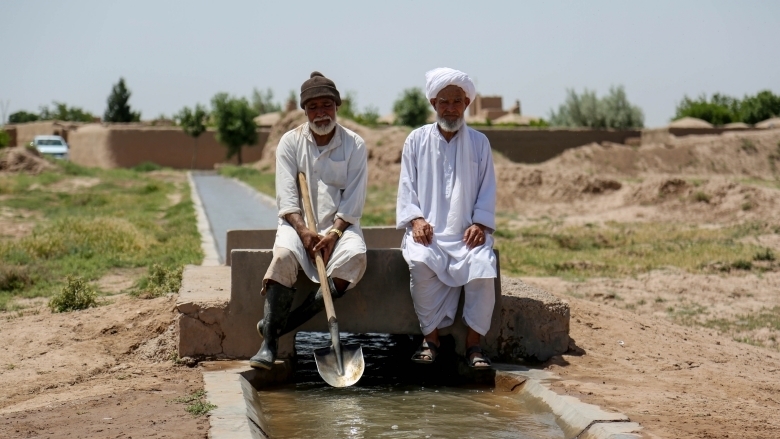Enjil district, Herat Province – Karim soaks his scarf in water and puts it on his head on this hot day. He walks towards a canal intake gate, his gray shirt wet with sweat. He clears the canal of any trash and shovels the gravel out from its bottom. He is tasked to inspect the canal daily to make sure it is clear and free of leaks.
“In the past, there were 70 people assigned on a daily basis in the winter to clear the canal and prepare it for irrigation,” says Karim. “Now I am the only person responsible for cleaning and taking care of the canal. There is no need for scores of people to clear it anymore.” Every month one of the villagers volunteers to clean the canal.
Karim is a farmer in Herat Province. He cultivates mainly wheat on his farm of 20 jeribs (40,000 square meters). The rehabilitated irrigation canal has allowed him to irrigate larger tracts of land, and he is now able to cultivate all of his farmland, compared to only 15 jeribs previously.
Prior to the rehabilitation of the canal, Karim and his fellow villagers were able to irrigate only a part of their land because of water wastage. Villagers blocked the flow of water with sandbags to divert the water to their own farmlands. This became a lengthy process in which much of the water was wasted. Today, it only takes a few minutes to open or close one of the newly built metal intake gates along the canal to direct water toward a tract of farmland, preventing any water loss along the way.
Kushk-e-Baad-e-Saba village has 1,900 jeribs of arable farmland. However, village farmers were able to cultivate and irrigate only 815 jeribs of land in the past. The rehabilitation of the irrigation system has increased the area of arable land to 974 jeribs. “My crops suffered and I could only cultivate half of my land,” recalls farmer Yasin. “Now I can easily irrigate all 15 jeribs of land. Our economic conditions have improved. We earn enough to put food on our tables and, with God’s help, do not depend on anyone else.”
The reconstruction project, which included the building of the intake gates, in Kushk-e-Baad-e-Saba village took 10 months to complete and was finished in September 2014. Built by the On-Farm Water Management Project (OFWMP), the canal stretches 3,315 meters and benefits more than 330 families. The reconstruction cost was about 6.7 million Afghanis (about $96,500).
With a $25 million grant from the Afghanistan Reconstruction Trust Fund (ARTF), OFWMP works to improve agricultural productivity in project areas by enhancing the efficiency of water use. It is implemented by the Ministry of Agriculture, Irrigation, and Livestock (MAIL).
The project aims to support on-farm water management investments in five regions—Kabul, Baghlan, Herat, Nangarhar, and Balkh Provinces—covering a total of 19,000 hectares. OFWMP has implemented 35 projects in western Afghanistan, especially in Herat Province, since it began operating in 2011.

